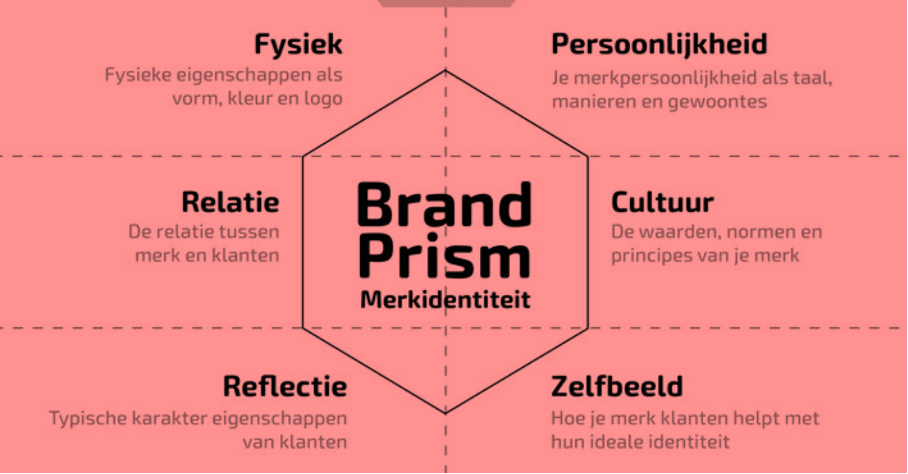When I started my first company, I thought a good product was enough. But I soon noticed that customers do not only buy based on quality, but especially on emotion and recognition. A consistent brand identity turned out to be the key to success. But how do you build it? A strong brand identity model is essential for this.
What is Brand Identity?
Brand identity is the way in which your brand presents itself and how it is perceived by your target group. It includes visual elements such as logos and colors, but also tone of voice, core values and brand personality. A strong brand identity model helps you to align all these aspects.
The Brand Identity Model
There are various models to define a brand identity, but one of the most commonly used is the Kapferer Brand Identity Prism. This model consists of six elements:

- Physical
This concerns the tangible characteristics of your brand: use of color, logo, typography, packaging and visual style. Think of the red of Coca-Cola or the minimalist look of Apple. What does your brand look like and what does it radiate? - Relationship
How does your brand interact with customers? This can be about service, communication, loyalty programs or even the way you handle complaints. Strong brands build a relationship, like Nike with athletes or IKEA with do-it-yourselfers. - Personality
Every brand has a character and a way of communicating. Is your brand playful and informal or businesslike and serious? The tone of voice and appearance determine how customers experience you. Think of the humor of Bol.com versus the serious and expert tone of De Nederlandsche Bank. - Culture
These are the core values and beliefs of your brand. What drives your organization? Culture can also include unwritten rules, such as how employees interact with each other or how decisions are made. For example, Patagonia is strongly focused on sustainability, which is reflected in everything. - Reflection
This describes what your target group looks like. What are the typical characteristics of your customers? Brands like BMW focus on successful professionals, while HEMA appeals to a broad audience with accessible products. - Self-image
How does your brand help customers see themselves as they want to be? This is about aspiration. People who use Apple products see themselves as creative and innovative. Starbucks customers identify with a premium lifestyle.
The face of your brand: visual brand identity
The visual identity encompasses all visible aspects of your brand. This determines how people recognize and experience your brand. Think of:
- Logo – The symbol or wordmark that makes your brand instantly recognizable.
- Color palette – Colors evoke emotions and reinforce your brand message.
- Typography – Fonts contribute to the appearance of your brand (modern, classic, playful).
- Design – Layout, icons and style elements that make your communication visually unique.
- Imagery – Photos, illustrations and videos that reinforce your brand story.
You can have the best product or service, but if your brand looks disjointed, people won’t stick around. Recognizability is key. If you use the same colors, fonts and style elements everywhere, people will remember your brand.
Verbal brand identity
Your verbal identity is everything your brand says and how you say it. Think of:
- Company name – Short, powerful, easy to remember and matching your brand.
- Slogan & pay-off – Think of “Just Do It” (Nike) or “Because you’re worth it” (L’Oréal). These are mini-stories that summarize your brand.
- Tone of voice – Do you speak formally or informally? Are you businesslike or playful? Your tone of voice determines how people feel about your brand.
- Way of writing & speaking – Think of web texts, social media posts, advertisements, customer service. The same style should be reflected everywhere.
You are not the only one in your industry. But a unique voice can distinguish you from the rest. Suppose two companies sell the same product, but one writes dry, standard texts and the other has a fresh, catchy tone of voice. Who sticks? The same goes for sending messages, e-mails and connection requests. The best way to stand out is simply to be yourself!
Why is a strong brand identity important?
A well-defined brand identity ensures:
- Recognizability – Customers recognize you immediately and know what your brand promises.
- Consistency – The same look and message across all channels.
- Trust – A clear and reliable brand attracts loyal customers.
Do you want to develop a stronger brand identity? Start by filling in the brand identity model and create a solid foundation for your brand! Are you curious about what we can do for you? Then contact us!🚀













